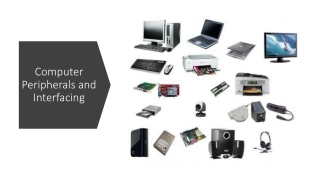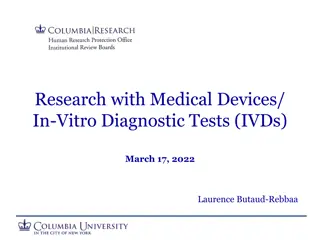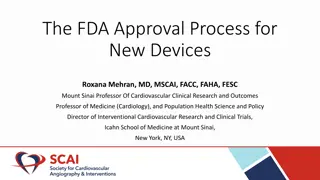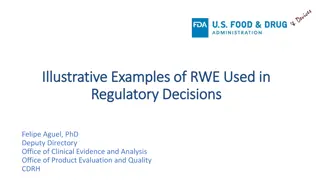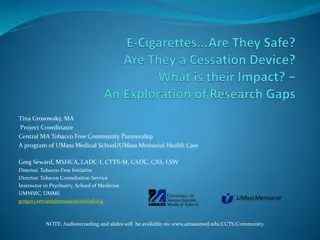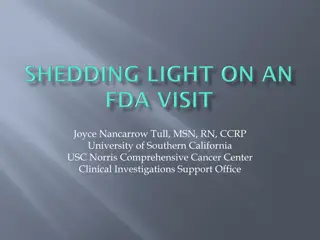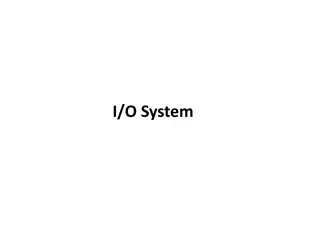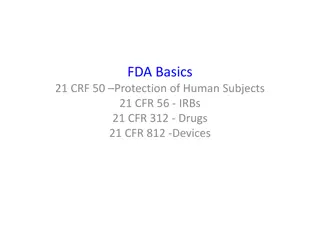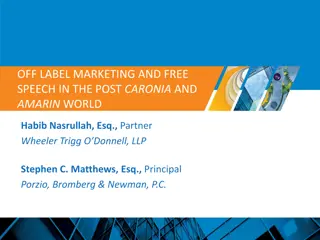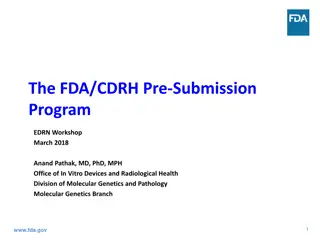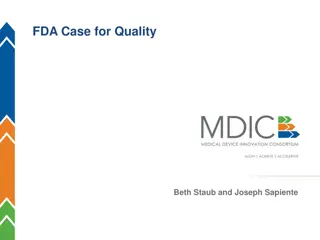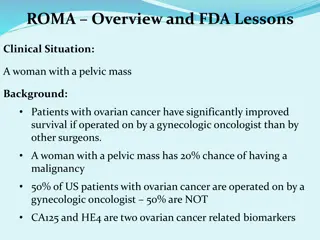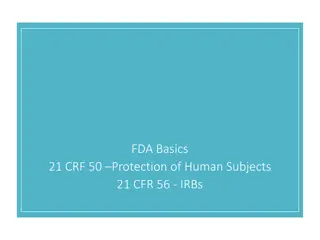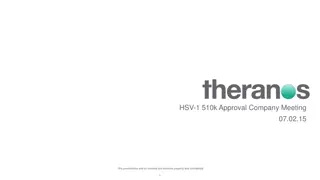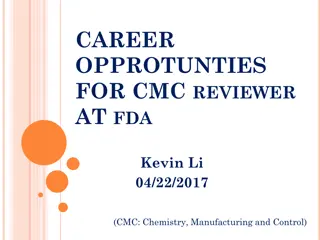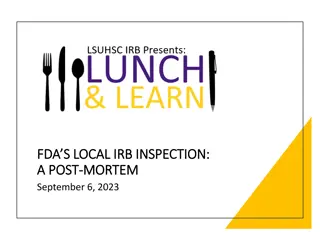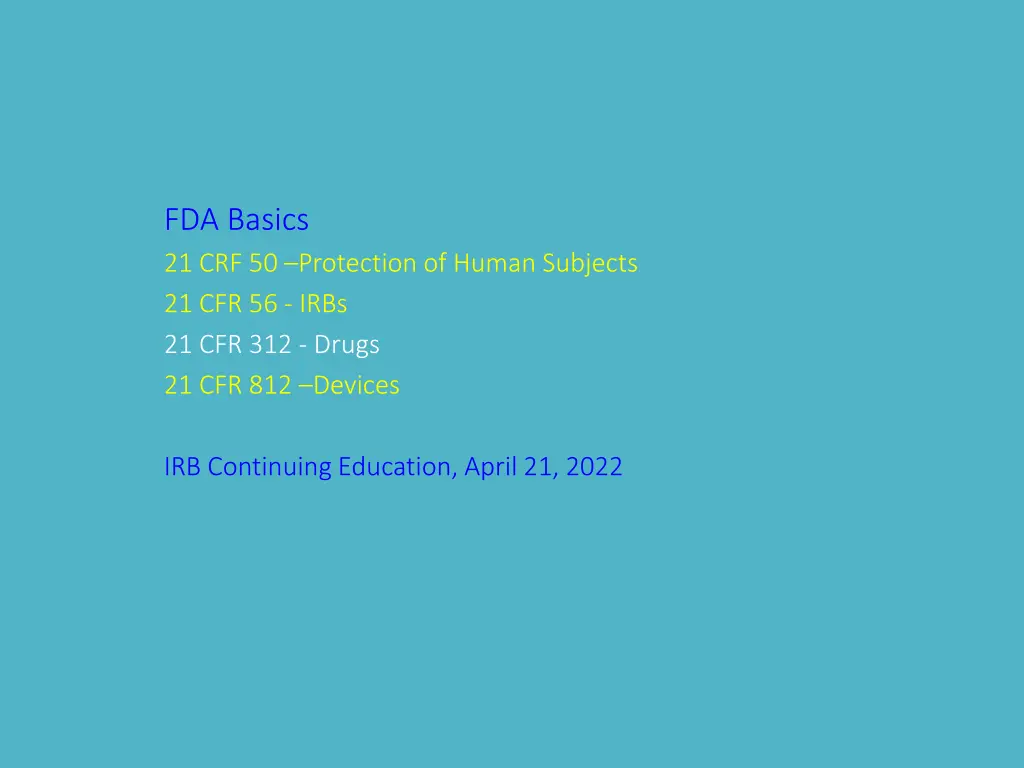
Understanding FDA Regulations: Research, Devices, and IRBs
Explore the key aspects of FDA regulations pertaining to conducting research with drugs, devices, supplements, botanicals, or biologics, as well as the definitions of human subjects and devices. Learn about the role of the Institutional Review Board (IRB) in assessing risks associated with devices.
Download Presentation

Please find below an Image/Link to download the presentation.
The content on the website is provided AS IS for your information and personal use only. It may not be sold, licensed, or shared on other websites without obtaining consent from the author. If you encounter any issues during the download, it is possible that the publisher has removed the file from their server.
You are allowed to download the files provided on this website for personal or commercial use, subject to the condition that they are used lawfully. All files are the property of their respective owners.
The content on the website is provided AS IS for your information and personal use only. It may not be sold, licensed, or shared on other websites without obtaining consent from the author.
E N D
Presentation Transcript
FDA Basics 21 CRF 50 Protection of Human Subjects 21 CFR 56 - IRBs 21 CFR 312 - Drugs 21 CFR 812 Devices IRB Continuing Education, April 21, 2022
So, what is FDA regulated? Conducting research with drugs, devices, supplements, botanicals, or biologics Includes those that have received FDA approval as well as investigational items Submitting data to the FDA to support approval/marketing
The FDA regulations are different Human subject not defined by identifiability Means an individual who is or becomes a participant in research, either as a recipient of the test article or as a control. A subject may be either a healthy individual or a patient.
The FDA regulations are different Research = clinical investigation Means any experiment that involves a test article and one or more human subjects
What is a device? Per Section 201(h) of the Food, Drug, and Cosmetic Act, a device is: Per Section 201(h) of the Food, Drug, and Cosmetic Act, a device is: An instrument, apparatus, implement, machine, contrivance, implant, in vitro reagent, or other similar or related article, including a component part, or accessory which is: 1) Recognized in the official National Formulary, or the United States Pharmacopoeia, or any supplement to them, intended for use in the diagnosis of disease or other conditions, or in the cure, mitigation, treatment, or prevention of disease, in man or other animals, or or 2) Intended to affect the structure or any function of the body of man or other animals, and which does not achieve its primary intended purposes through chemical action within or on the body of man or other animals and which does not achieve its primary intended purposes through chemical action within or on the body of man or other animals and which is not dependent upon being metabolized for the achievement of its primary intended purposes. The term "device" does not include software functions excluded pursuant to section 520(o). and
What does the IRB need to do? The FDA requires the IRB to do a risk assessment of devices If non-significant risk no IDE is needed If significant risk IDE is needed
How does the IRB make a risk determination? Researcher must provide sufficient information: Researcher s risk assessment and rationale Sponsor s risk assessment and rationale FDA determination (only when an IDE application has been submitted) FDA Significant Risk determination overrides the IRB s decision FDA Non-significant determination IRB may agree or disagree
IRB risk determination considerations If a risk assessment has already been made Risk determination for other uses of the device Sponsor s risk assessment and rationale Researcher s risk assessment and rationale Procedures Population Review of the device by other IRBs
Non-significant risk device examples Conventional Gastroenterology and Urology Endoscopes and/or Accessories Magnetic Resonance Imaging (MRI) Devices within FDA specified parameters Daily Wear Contact Lenses and Associated Lens Care Products not intended for use directly in the eye (e.g., cleaners; disinfecting, rinsing and storage solutions) Digital Mammography
Significant risk device examples Surgical Lasers for use in various medical specialties Cardiac Bypass Devices Auditory Brainstem Implants Dialysis Delivery Systems Injectable Collagen
The determination has been made 1. Documentation using the CHECKLIST HRP-418: Non- Significant Risk Determination 2. Communication To the researcher To the sponsor To the FDA (responsibility of sponsor)
If FDA regulated Additional consent form elements: FDA review of records Clinical trial registration Risk information Waiver of consent Not only limited to emergency research Harmonizes with HHS Waiver of documentation of consent More limited than HHS
If FDA regulated Items made here IRB may require information about the manufacture Consultation with HU Risk Management or related Control of investigational items Review plan of control, tracking and handling Records Maintain records about the use of the item, including records of receipt, use, or disposition Where obtained IRB has authority to require use of local services

